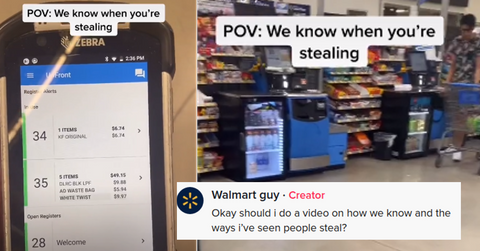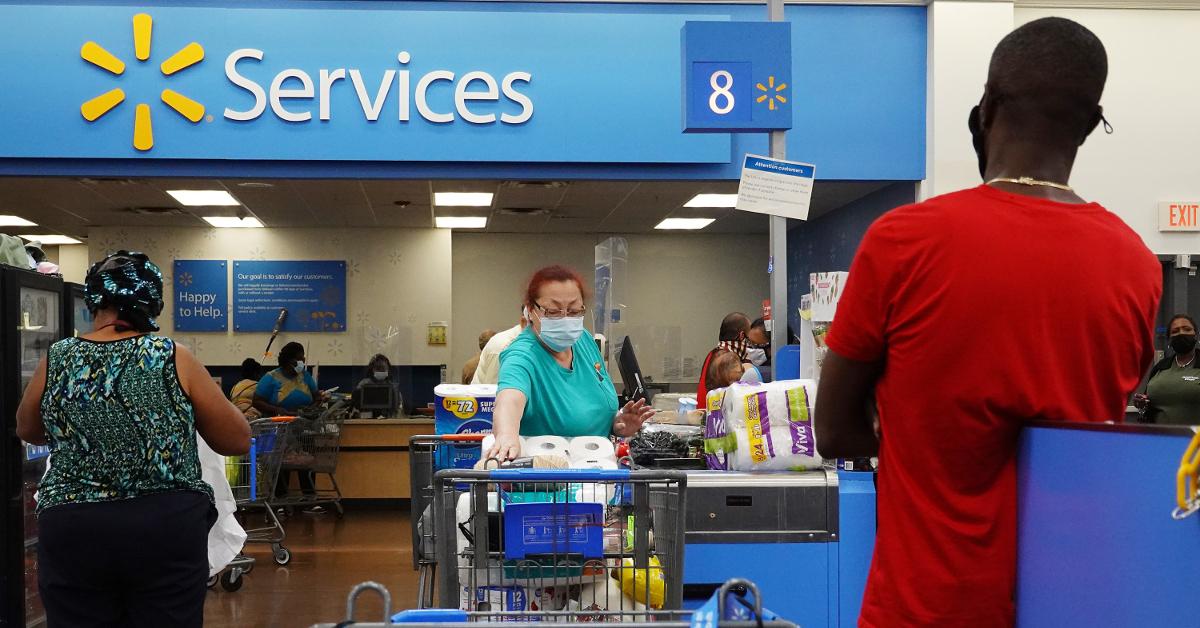Walmart Employee Exposes Clever Way They Know When Someone’s Stealing at Self-Checkout
Updated May 21 2023, 4:17 p.m. ET

We've become so accustomed to self-checkout lanes in grocery stores that it's a bit aggravating whenever you got into one and see that the option isn't available.
This is especially true of Walmart, one of America's largest brick-and-mortar retailers that are known for its low, low prices, the subject one of the internet's earliest hilarious, if not a bit mean, viral meme websites, and for having a gajillion cash register lanes, with only two open to process transactions at the same time.
Personally, I've returned my items so many times due to long lines that I entirely stopped shopping at Walmart for years, until I heard my local one implemented a self-checkout lane.
It's understandable why some stores would be wary of installing these in a location, however. It definitely seems like a shoplifter's dream come true.
Faking out the weight system shouldn't be too difficult, especially if one knows how heavy the items they plan on buying beforehand are. All you'd have to do is get the appropriate poundage down and you'd be able to scan lower-cost items to score a couple of free goodies on your own without arousing suspicion.
But one Walmart employee revealed how the store goes about stopping would-be thieves.

@thewalmartguy69 (nice) posted a clip to TikTok that's making the rounds on the popular social media platform with a text overlay that reads: "POV: We know when you're stealing."
In the clip, the employee shows a nifty little gizmo developed by Zebra Technologies that's designed specifically for retailers to "spy" on customers and survey the items they're bringing to self-checkout.
In the clip, the device can be seen monitoring the items customers scan and if there's anything amiss, it will "register alerts." The scanner is supposed to ascertain whether or not there's any tomfoolery going on and if customers are actually scanning everything they put into their bags at self-checkout. You check out (heh) the post below:
While there were some people who were impressed and/or a bit scared of trying to sneak that extra pack of string cheese into their bag during their next Walmart visit, others plainly stated that they didn't put much faith in the gadget developed by Zebra technologies.
"I walked out of Walmart with one of those big bags of dog food because I forgot to pay for it. It was under the cart; I didn’t see it," one user said.


Others talked about either forgetting items in their cart or simply forgetting to swipe while at the self-checkout aisle and walking directly out of the store: "I literally walked out with $50+ worth of items on accident because I forgot to swipe my card."


Others were a bit more blatant with the way they shop at Walmart: "I always take one small item as payment for being my own cashier. I don’t work for free."


Then there were users who expressed their befuddlement with the tech: "If y’all know when we’re stealing...why do you guys stare at us like we’re up to something when we’re not?"


Even other Walmart employees chimed in stating that they were not paid "enough to care" and that they would simply look the other way if they learned a customer was stealing from the business.


According to research and analytics, it's in Walmart's best interest to equip its stores with all of the devices that it can to help curb theft from its stores given the huge losses they reportedly incur as a result.


According to Fortune, Walmart states that the corporation loses 1% of potential profits every single year because of theft. With around $300 billion in sales generated in 2015 (the year the article was published) across all of its stores over the world, that's a whopping $3 billion. More recent statistics have placed those figures much higher: in 2020 Walmart generated a reported $523.96 billion in revenue, meaning they gave up over $5 billion in potential earnings due to theft.


Since 2015, Walmart's been actively working on mitigating its losses. Active human monitoring from its loss prevention departments can only go so far, however, which is probably why its implementing the use of technology from companies such as Zebra.


As far as losing sales due to theft, a 1% loss estimation is a rather conservative figure. Businesses can expect to lose up to 3% of profits a year due to in-store thievery.


Forbes also reported on the economics of how much Walmart should spend every single year in attempting to stop thieves. In the 2016, a local police officer stated that the retailer could definitely be doing more to minimize the amount of thefts that occur in their store, even intimating that a big chunk of his local department's time is spent investigating crimes at a specific Walmart location.


Forbes went on to quote a financial analyst that it may not make sense for the company to invest heavily in as-close-to-total loss prevention: "The cost would be about $3.25 billion a year, or about a quarter of Walmart’s profit last year of $14 billion."

So the moral of the story is that Walmart's probably only spending as much money as they can before it's just more profitable to let you walk out of the store with those And 1 slippers who've had your eye on.